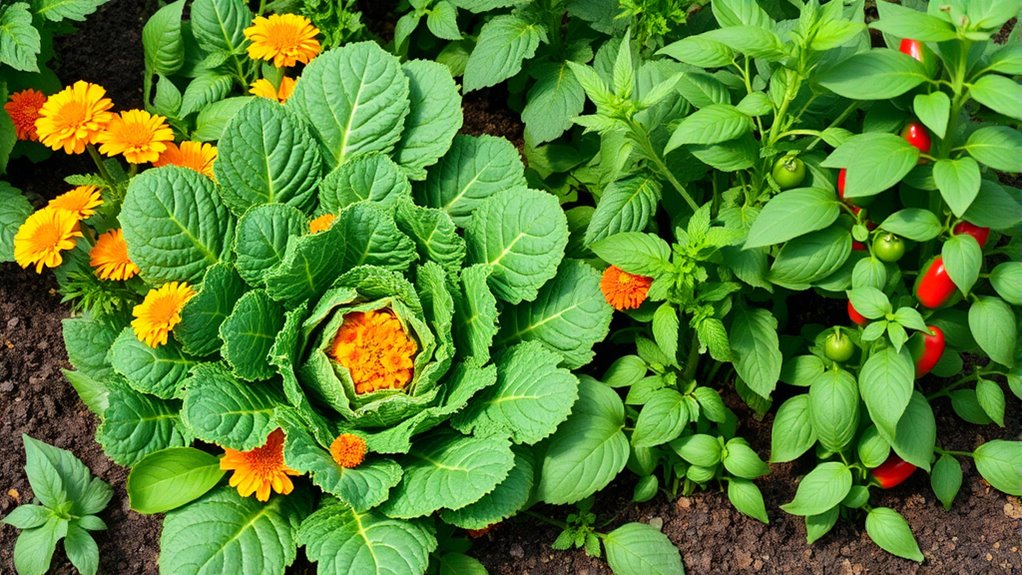To boost your garden’s health and fight pests naturally, use companion planting. Plant marigolds around vegetables to repel nematodes and aphids, or add basil to deter mosquitoes and flies. Incorporate nitrogen-fixing beans to enrich soil and mix root systems like carrots with onions to reduce pests and improve drainage. A diverse planting scheme creates a balanced ecosystem that controls pests and promotes better growth. Keep exploring to discover more effective plant pairings and techniques.
Key Takeaways
- Use pest-repellent plants like marigolds and basil to naturally deter pests and protect crops.
- Incorporate nitrogen-fixing legumes to enrich soil and promote healthier plant growth.
- Plant diverse species to increase biodiversity, reducing pest outbreaks and encouraging beneficial insects.
- Combine plants with complementary root systems to improve soil structure and enhance plant resilience.
- Practice sustainable gardening by reducing chemical use and fostering a balanced, productive ecosystem.

Companion planting is a simple yet effective way to naturally control pests and promote healthier plant growth. When you choose the right plants to grow together, you can reduce the need for chemical pesticides and create a thriving garden ecosystem. One of the most powerful aspects of companion planting is how it utilizes natural pest repellents. Certain plants emit odors or substances that disrupt pests’ senses, keeping them away from your valuable crops. For example, marigolds are known to repel nematodes and aphids, while basil can deter mosquitoes and flies. By strategically placing these plants near your vegetables and herbs, you create a natural barrier that discourages pests from settling in.
Companion planting uses natural pest repellents like marigolds and basil to protect crops and promote healthy growth.
Alongside pest control, companion planting also enhances soil health through soil enrichment techniques. When you plant nitrogen-fixing legumes like beans or peas alongside other plants, they naturally enrich the soil with nitrogen, an essential nutrient for plant growth. This reduces your dependency on synthetic fertilizers and encourages a more sustainable approach. Additionally, certain companion plants help improve soil structure by adding organic matter or preventing erosion. For instance, cover crops like clover not only fix nitrogen but also prevent weed growth and improve soil aeration.
You can further boost your garden’s significance by considering how different plants interact below the surface. Some root systems complement each other, helping to break up compacted soil and improve drainage. Planting carrots with onions, for example, can repel pests and also optimize the use of underground space. These combinations create a balanced environment where plants support each other’s growth, making your garden more resilient and productive.
Furthermore, companion planting encourages biodiversity, which naturally deters pests and diseases. When your garden hosts a variety of plants, pests find it harder to locate their preferred hosts, and beneficial insects like ladybugs and pollinators thrive. This ecological balance minimizes pest outbreaks and enhances pollination, leading to better fruit and vegetable yields. Incorporating vetted plants and techniques ensures your garden remains healthy and sustainable over time. By adopting these techniques, you’re fostering a healthy, sustainable garden that relies less on chemical interventions.
Frequently Asked Questions
Can Companion Planting Replace Chemical Pest Control Completely?
You might wonder if companion planting techniques can fully replace chemical pest control. While natural pest barriers created by strategic plant pairings help reduce pest problems, they often aren’t foolproof. Relying solely on companion planting might leave some pests unchecked. Combining these techniques with other integrated pest management methods offers a more reliable approach, ensuring healthier plants without solely depending on chemicals.
Which Plants Are Best for Attracting Beneficial Insects?
Think of your garden as a bustling city for beneficial insects. To attract pollinator attraction and create pest predator habitat, plant flowers like marigolds, coneflowers, and dill. These plants draw in bees, butterflies, and predatory insects, helping keep pests in check naturally. By choosing the right plants, you support a thriving ecosystem that enhances growth and reduces the need for chemical interventions.
How Does Companion Planting Affect Plant Nutrient Uptake?
Companion planting influences your plants’ nutrient absorption by improving soil nutrition and balancing soil chemistry. When you plant certain species together, they can enhance nutrient availability, reduce competition, and promote healthier roots. For example, legumes fix nitrogen, boosting soil nutrition for nearby plants. This synergy helps your plants access essential nutrients more efficiently, leading to better growth and stronger overall health. Proper companion planting optimizes nutrient uptake naturally, reducing the need for fertilizers.
Are There Any Plants That Should Not Be Grown Together?
Think of your garden as a lively neighborhood where some neighbors just don’t get along. Conflicting plant combinations and incompatible plant pairings can lead to poor growth or pest issues. For example, fennel and dill tend to clash, while tomatoes and potatoes share pests. To keep your garden harmonious, avoid planting these incompatible pairings. This way, your plants thrive, and your garden becomes a vibrant, peaceful community.
How Long Does It Take to See Pest Control Results?
You might wonder how long it takes to see pest control results, but it depends on pest population dynamics and your chosen methods. Typically, you’ll notice a reduction within a few days to a week if you use effective strategies like natural predators or insecticidal treatments. The timing of pest control is essential; early intervention often leads to faster, more noticeable results, helping keep pest numbers in check and protecting your plants.
Conclusion
By embracing companion planting, you gently invite nature’s harmony into your garden. It’s like creating a welcoming dance where plants support and protect each other, reducing the need for harsh measures. As you nurture these friendly relationships, you’ll discover a more vibrant, resilient garden that thrives with less effort. So, enjoy the subtle magic of these pairing secrets—your plants will thank you with healthier growth and a more peaceful, flourishing space to call home.










